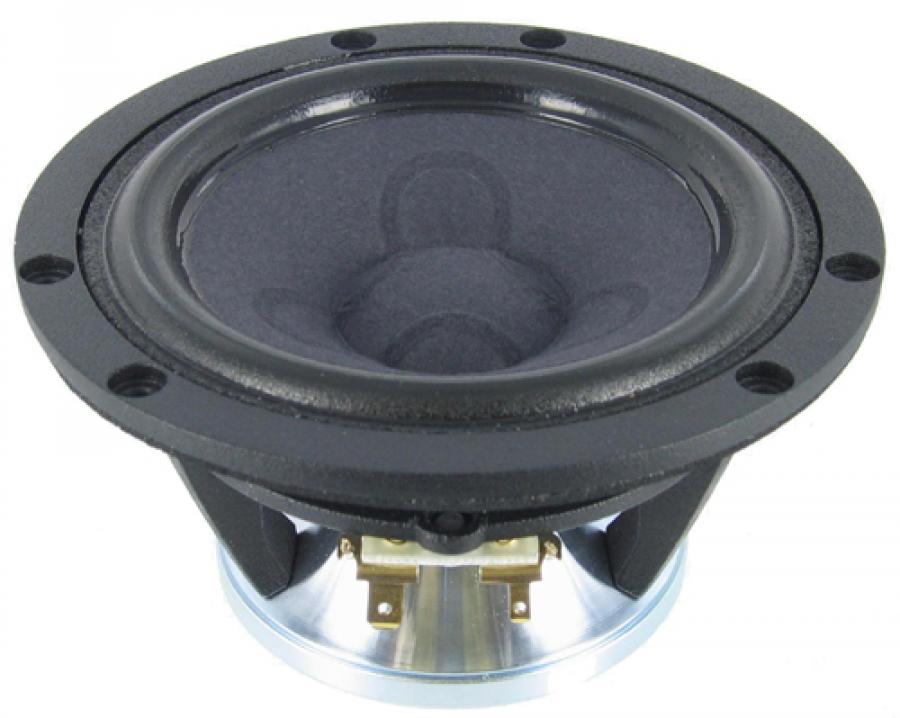I had previously posted the design specs for the SNR-1, a high quality, two-way speaker. I've been very pleased with their performance but my center channel speaker was a much more budget-conscious effort.
Two Way vs. Three Way
The
biggest change I wanted to achieve was to go from a 2-way center to a
3-way, and from passive to active. Center channel speakers have unique
crossover and dispersion constraints. They need to fit horizontally
under or over a television which makes us immediatley want to use a WTW
arrangement, but the 2-way alignment forces rather narrow dispersion due
to the tweeter cutoff frequency limitations. A 3-way center has to be taller to accommodate the midrange under the
tweeter but this also gives us much better opportunities for horizontal
and vertical dispersion as well as power handling.
Consider that the LM-C uses a single crossover at around 2 kHz. That means the 4" woofers on the side are going to be beaming from about 500 Hz to then. It also means the tweeter is being pushed lower frequencies and therefore limiting the power handling. Like other 2-way center speakers, the LM-C sounds fine, but creatively I want to push the performance envelope.
Inspiration
Taking a look at Troels Gravessen's Illuminator Center Channel
got my wheels turning. He showed me that a high quality 3-way center
could be done with just 10" of height. Honestly Troels work differed a
great deal from the center channel I would have liked, so starting from
the Illuminator 4" midrange I have planned out my own high-end center,
which is about the same cost but much smaller and better suited for my
listening space.
I
consider Troels kind of a speaker designer soul brother. I'm not nearly as
skilled or as prolific but I often find little nuggets of wisdom in his
writing that makes me go "aha! Me too!" so I always want to encourage
DIY'ers to go there looking for designs and inspiration.
"What
can you do better?" you might ask. Well, nothing, but I want different
things than Troels' design offers. I also found an interesting line of
powered centers from ATC which I've seen between $12,000 USD and
20,000, which again, didn't quite do what I personally want. Price is an issue but so is size! Those steep prices make
me feel the idea of a powered high quality center with larger woofers
was worth pursuing for more than just myself.
What do you do when you can't eat the meal you want? You cook it yourself, of course!
It is really kind of unfair to Troels and ATC for me to take their designs on as foils, but I think that they work really well as explanatory contrasts. This design I am starting will not be better, it will be better for me but I want to share with you how and why.
Perhaps I can start a trend for high output but small, bass limited center channels?
Quality of Life
In terms of living with this speaker, it's going to go on top of my
Butcher Block Acoustics rack
and below my TV. This means it has to be smaller but also allow for
flexibility in cleaning up bass issues that are going to occur from the
shelf location and these are important do deal with because they
interfere with dialogue clarity and no two placements are the same.
This is something even the ATC speakers can't offer me. I also don't want to rely on automated room correction anymore, I like my own sauce better. More on that below.
Quick math based on published specs, the SNR-C will be 40% smaller than Troels' concept and more than 4x smaller than the ATC C6CA but I'll be i the ballpark of the ATC for power handling and dynamic range. I'm more than happy to trade off absolute bass extension for a significantly smaller cabinet.
Cabinet Size
Among
the biggest changes I'm making is the cabinet size. The SNR-C will measure 24" wide by 10" tall by 12" deep. Not as
tiny as many slim centers but certainly smaller than their ported
cousins. Troels and the ATC
end up with pretty wide and deep center channel speakers. They are
designed to be full range, placed on a dedicated stand. They go as deep
as many floor standers, down to 40-50 Hz thanks to the large internal
volume and ports. I absolutely don't need the bass extension, and the
ScanSpeak Illuminator/Revelator motors do an amazing job with just 6.5"
of cone diameter.
The first thing to go from
either inspirational idea is the ports. These are going to be sealed
cabinets that get me down to 55 Hz with 30% less volume, which for a
satellite we'll cut off at 80 Hz anyway that's perfect. Why build a
full-range speaker when you don't have to? Using a sealed
cabinet means we don't have to worry about cone excursion below the port
frequency, and therefore we don't have to worry about distortion in the
bass at high volumes.
On a side note: Audiophiles have this myth
that you are better off getting your mains as low as possible and then
sliding the sub underneath. I can't tell you how many of them raise
the cutoff to 80Hz or higher and then go "Oh my god! My speakers sound
so much clearer, even imaging is better!" so if you are sitting there
thinking I should make a full-range center channel to go deep, and
minimize the sub contributions to 40Hz or lower you are wrong. I have
spoken and it is thus forever and always.
Drivers
Mid-Woofers
I
have been living with the ScanSpeak Revelator mid-woofers for about 5
years and have found nothing I like better. Troels splurges here and
steps up to the Illuminators, but the devil I know plus a conversation
with
Fritz of Fritz Speakers convinced me not to spend the additional $200. The
Revelator 18/8531G-00
are phenomenal all by themselves and will better match my SNR-1. Using
the 8 Ohm version in parallel will let the amp deliver a little more
output.
The money we save here goes to a better tweeter, below. It is fair to say that audiophiles spend too much attention and money on tweeters given that most of the sound output comes from the mid and woofers but in this particular case, I'm really comfortable with the mid-woofers punching above their price class.
We
should note that with Troels' design as the ATC designs we have
unusually large woofers for a center channel. The dual 6.5" drivers
provide unusually large amounts of surface area and power handling for a
center channel, most of which are made to be ultra slim. We hope this
translate+es directly into increased dynamic range and output.
Midrange
Here we splurge, the
Illuminator 12MU/4731T-00, as Troels suggests, is our answer for low distortion and relatively high output.
Tweeter
In
the SNR-1 I used Mundorf AMTs but part of my goal was to limit vertical
and horizontal dispersion, making them more room friendly but I take a
different approach here. For the SNR-C I want as much dispersion as I
can get. It will sit away from the walls and no matter where I sit I
want to hear the center perfectly. The choice this time is the
D3004/6620-00.
Ever
since I first heard the ScanSpeak AirCirc motors at shows in various builds and in
Magicos I've wanted to build with them. Great transparency, high
frequency extension, dynamic range and glass smooth frequency response.
The money saved in the midwoofers is going here, but we stick with a
soft dome. To be honest, Troels use of the Discovery tweeter is also a great choice but I just really wanted to build with an AirCirc. You could however save $200 on this build if you stick to the Discovery tweeter and through the magic of active DSP controlled crossover you can!
Crossover? We don't need no stinking crossover!
But seriously folks, we are using the
Hypex Fusion 3-channel DSP controlled plate amplifier to
be our crossover and active amplifier. Using a crossover before the
amps is a huge win in terms of amplifier
dynamic range, in addition to eliminating losses usually found in
padding resistors. With our drivers the amp delivers 250+250+100 W of
power, or around 600, but due to the magic of active crossovers and
voltage to power mathematics this will be an amp with the equivalent
output of around 1,000 W or more. Either way, this is a huge upgrade
from the 100W/Channel of my
current Anthem MRX 540.
Ultimately
we are limited by the capabilities of the drivers themselves, but doing
a little power math puts us at around a maximum 118 dB at 1m, about
equivalent to the $20,000 ATC studio monitor models.
Through
the magic of digital delay we'll be able to create ideal Linkwitz-Riley
aligned, 4th order crossovers with a number of good outcomes:
- Steep filters will prevent driver to driver interference off axis and eliminate lobing.
- All drivers in positive phase
- Increased dynamic range for the mid and tweeter
- Customized EQ for on-shelf placement
If
you notice Troels' design uses 2nd and 3rd order filters exclusively
along with inverting all but the woofers. In this particular case any
speaker designer is going to be limited by the fact that the different
acoustic centers force us into such choices. The digital delay will
give us ideal acoustic centers (at least from the front) allowing for
ideal LR4 alignment.
As any crossover
designer should know however, what matters isn't the order of filters,
but the filters PLUS the driver response. Until I have the speaker in
my lab (haahaha) I won't know exactly the steepness of the active
filters used to achieve LR4.
A small side
benefit which perhaps only I would care about is that honestly I've not
been that impressed with the Anthem ARC and I want to try turning it off
and using my own EQ curves. I feel like I had much better immersion
when I did all the EQ by hand. We'll see!
CAD Rendering
Here is the first rendering I have from the cabinet shop currently tasked to produce unit zero:

Sound Quality
I
am confident in my skills at satisfying my needs and preferences, but I
have no idea what these will sound like until they are actually
finished, which is far away, but from a planning and engineering
perspective I'm pretty much satisfied with my design goals and that at
least on paper this design should meet them.
A
lot of enthusiasts will balk at the idea of DIY speakers. They find
the idea that you could make something that qualifies as a "high-end"
speaker yourself, and immediately get onto their soap boxes about how I
can't possibly build what Wilson or MBL builds. That's fine, that's not
my goal. The way I enjoy my hobby is by making speakers as opposed to buying them. I don't
personally care if you feel these speakers are better than brand X.
They only have to satisfy me in the end. My purpose in sharing this
with you is in the hopes to inspire more builders and let others know
what I'm up to and where my perspectives lie.


